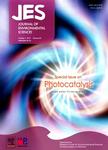A bioaugmentation failure caused by phage infection and weak biofilm formation ability
A bioaugmentation failure caused by phage infection and weak biofilm formation ability作者机构:State Key Laboratory of Microbial Resources Institute of Microbiology Chinese Academy of Sciences Beijing 100101 China Graduate University of Chinese Academy of Sciences Beijing 100039 China Institute of Oceanology Chinese Academy of Sciences Qingdao 266701 China
出 版 物:《Journal of Environmental Sciences》 (环境科学学报(英文版))
年 卷 期:2009年第21卷第8期
页 面:1153-1161页
核心收录:
学科分类:0710[理学-生物学] 0830[工学-环境科学与工程(可授工学、理学、农学学位)] 071010[理学-生物化学与分子生物学] 081703[工学-生物化工] 07[理学] 08[工学] 0817[工学-化学工程与技术] 0836[工学-生物工程] 082203[工学-发酵工程] 0822[工学-轻工技术与工程]
基 金:supported by the Hi-Tech Research and Development Program (863) of China (No.2006AA100305)
主 题:marine culture water circulation ammonia removal Lutimonas sp. HIO nitrification breakdown fluorescent in situhybridization (FISH)
摘 要:Two biological aerated filters (BAF) were setup for ammonia removal treatment of the circulation water in a marine aquaculture. One of the BAFs was bioaugmented with a heterotrophic nitrifying bacterium, Lutimonas sp. H10, where the ammonia removal was not improved and the massive inoculation was even followed by a nitrification breakdown from day 9 to 18. The nitrification was remained stable in control BAF operated under the same conditions. Fluorescent in situ hybridization (FISH) with rRNA-targeted probes and cultivable method revealed that Lutimonas sp. H10 almost disappeared from the bioaugomented BAF within 3 d, and this was mainly due to the infection of a specific phage as revealed by flask experiment, plaque assay and transmission electron observation. Analyses of 16S rRNA gene libraries showed that bacterial groups from two reactors evolved differently and an overgrowth of protozoa was observed in the bioaugmented BAF. Therefore, phage infection and poor biofilm forming ability of the inoculated strain are the main reasons for bioaugmentation failure. In addition, grazing by protozoa of the bacteria might be the reason for the nitrification breakdown in bioaugmented BAF during day 9-18.



